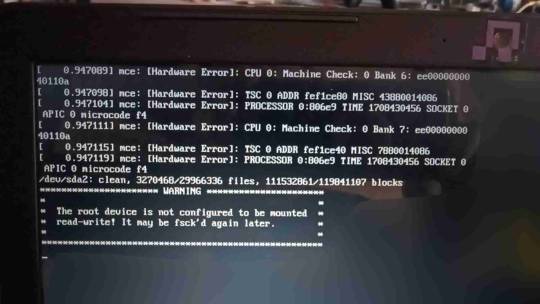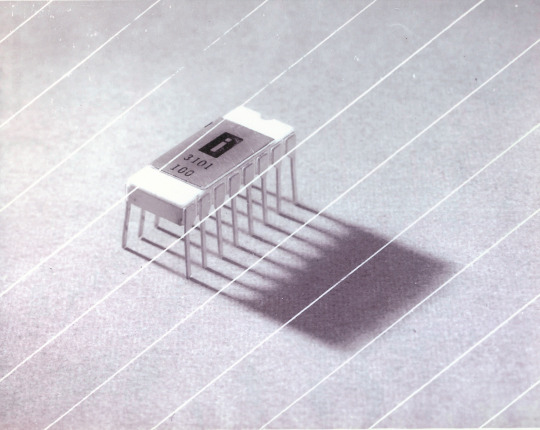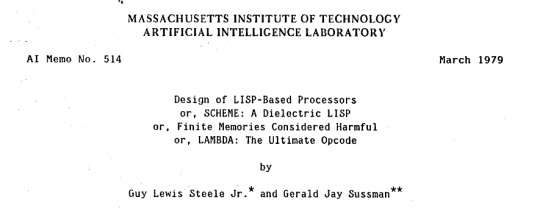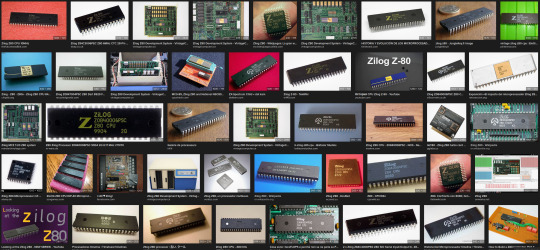#Microcode
Explore tagged Tumblr posts
Text
realising with horror that in the cool chips post I somehow called it P5 microarchitecture instead of P6 microarchitecture and it's just been sitting there for months
9 notes
·
View notes
Text
CPU microcode hack could infect processors with ransomware directly-Latest New 2025
A researcher from Rapid7 created a working Proof of Concept for a CPU ransomware Such a ransomware would persist on a device even after the hard drive had been replaced The PoC will (most likely) never see the light of day A security researcher wrote ransomware code that infects the computer’s CPU, making it invisible to virtually every antivirus program out there, and making it persistent even…
0 notes
Text
Navigating the Intel Core Stability Saga: Microcode Updates, Performance, and Thermal Challenges
Picture this: You’ve just bought or built your dream PC, complete with an Intel 13th or 14th-gen processor. You fire it up, ready to conquer the digital world. But wait—what’s this? Crashes, freezes, and system instability? It’s like your CPU decided to moonlight as a drama queen. 🤯 Initially, fingers pointed at overclocking enthusiasts. “You must have pushed that CPU too hard!” they said. But…
#14th gen#BIOS#bug fix#CPU#Intel Core#Microcode#Processor#Raptor Lake#stability#Technology#troubleshooting#unstable#voltage
0 notes
Text
We have compiler at home
0 notes
Text

pretty girls named Hardware Error are sending me lewds anad promising to fsck me again later 😊 😍 🥵
#pspsps objectum likers let me show you the world#mad i can't use the cathode.church blushy robot emojos here tbh#it works just fine like this but when i switch to the TTY the hardware error is THERE to GREET ME#the fsck warning is fine i just cba to change my grub config until later today#the microcode warning? not a fucking clue but she doesn't seem to care so neither do i#linux#objectum#robophilia
192 notes
·
View notes
Text
ESX Üzerinde CPU İnceleme
Merhaba, bu yazımda sizlere ESX Üzerinde CPU İnceleme konusundan bahsedeceğim. esxcli hardware cpu list komutu, ESXi sunucusunun işlemci bilgilerini listelemek için kullanılır. Bu komut sayesinde ESXi sunucusunun üzerinde çalışan işlemciler hakkında detaylı bilgilere ulaşabilirsiniz. Aşağıda bu komutun sağladığı bazı bilgileri bulabilirsiniz: CPU Modeli: İşlemcinin model numarası ve…

View On WordPress
0 notes
Text
Software Development Company in India
The most successful software development company in India is called Microcode Software. Renowned for providing superior service and bringing forth novel concepts. The group consists of proficient programmers, designers, and engineers. For customers in a range of industries, they provide customized solutions. Using cutting-edge technology, it aims to produce robust, scalable software. Businesses benefit from maintaining their competitiveness. In terms of developing web and mobile apps, the company is unique. Its offerings never fail to astound.

Microcode Software uses the newest technologies and procedures. This guarantees the accuracy and thoroughness of each job. From beginning to end, the business supports customers' development and progress. It increases corporate success by giving ideas life. Please contact with us; we would be pleased to help you expand your business.
#software development#app development#web development#digital marketing#online marketing#microcode software#indian company
0 notes
Text
x87 is such an abomination.
Well, frankly the whole of x86 is an abomination. Forty years of backwards-compatibility-focused CISC extensions will do that to you.
But x87, man. 'Cause FPUs used to be discrete, optional chips, right? Your basic-ass 8086 couldn't do floating point whatsoever, you needed to install an 8087 alongside it for that. Likewise, the 80286 needed an 80287, and the 80386 needed an 80387, and it wasn't until the i486DX that the FPU was on the same package as the CPU.
So, y'know, you couldn't talk to it directly -- like a modern GPU. It was it's own processor. Ergo, you can't actually address its registers directly. It's a stack machine. Want to add two floats? You gotta send 'em over -- one at a time -- with the FPUSH instruction, then send an FADD, then FPOP to get the result back out.
There are two divide instructions. One for if the numerator is first on the stack, another for if the denominator is first.
And it's just... still like this. After forty years. Modern CPUs have their FPUs not but micrometers from the rest of the ALU, but you still have to talk to it like it's on a different bus. No other part of the ALU operates like a stack machine -- just the x87 stuff. And it'll continue to work that way. Forever.
We gotta move desktops to RISC, man. This shit is untenable.
#the streaming simd extensions make this much worse#by adding fpu registers the alu can access directly#of course the x87 registers can also be accessed directly now#just not by you#thats only for the microcode to do#oh god we need to burn it all down#my thoughts#computers#programming#x86#x87#assembly
0 notes
Text
Real Estate Website Development Services in India
Microcode Software is India's Best Real Estate Website Development Services provider. Specializing in creating bespoke online platforms for real estate professionals, Microcode Software offers cutting-edge solutions tailored to meet the unique needs of the industry.

With a focus on user-friendly interfaces, advanced functionalities, and seamless integration of property listings, their services empower real estate businesses to establish a strong online presence and attract potential clients effectively. From intuitive search features to robust backend management systems, Microcode Software ensures that every aspect of the real estate website is optimized for success, delivering top-notch quality and unparalleled customer satisfaction.
#real estate website development#real estate website#website development company#website development services#website development#microcode software#india
0 notes
Text
Travel Portal Development Company In India
Based in India, Microcode Software is a top travel portal development company. With an appreciation of innovation and an obsession with performance, we specialize in creating personalized travel solutions that are suited to each client's requirements. Utilizing the newest technology, our team of skilled software developers builds feature-rich, intuitive systems that improve user experiences and expedite booking procedures. Travel businesses may flourish in the digital era with the help of Microcode Software's innovative offerings, which include building flexible mobile applications, websites, and powerful backend systems.
#travel portal development#website development#website development company#website development services#microcode software#india
0 notes
Text
I am coming to you because I need an expert, and engineer who can do subtle work. See, I eventually push everyone away, and it hurts. I need you to take me apart and find the little broken things in me that cause this. And then remove them. Desolder them, route circuits around those bits, remove the microcode that makes it happen. Fix me, a little broken robot girl. Because otherwise I might try to fix it myself, and we both know I am a shit engineer.
823 notes
·
View notes
Text
On 68030 Development





In April of 2020, user [CaptainTivo] commented on [Ken Sherrif]'s look inside the Am2901 bit-slice processor:
The Apollo workstation ... actually emulated the 68000. I was in the Motorola 68000 design group from 1985 to 1996. The first project I worked on was the 68030, which was essentially the 68020 with an integrated MMU and virtual memory capability. We did have a full hardware breadboard of the 68020. The 68030 breadboard was 18 24"x24" wirewrap breadboards, each with a 23x14 array of 20 pin DIP sockets! The chips were mostly PALs and RAM/ROM, no bitslice. This was before software logic simulation was a real thing.
Normally I would not have been allowed to take pictures of this, or even bring a camera into the building, but I gave a talk on the 68030 at Stanford in 1986 and I got permission …
I did not work on the emulator (that was the Tiejen brothers), I did design on the TLBs.
The cards were about 24" on a side, with 20 pin wirewrap DIP sockets. Mostly PALs, RAMs and ROMs. Although the 68020 and 68030 have relatively complex instruction set, a lot it was implemented in microcode, so the actual logic is quite as hairy as you might think.
It's a fascinating look at what it took to develop a new CPU well into the late 1980s. Imagine what it would take to build out a hardware simulator for a modern CPU in this manner.
Thanks @commodorez for bringing this to my attention!
36 notes
·
View notes
Note
What are some of the coolest computer chips ever, in your opinion?
Hmm. There are a lot of chips, and a lot of different things you could call a Computer Chip. Here's a few that come to mind as "interesting" or "important", or, if I can figure out what that means, "cool".
If your favourite chip is not on here honestly it probably deserves to be and I either forgot or I classified it more under "general IC's" instead of "computer chips" (e.g. 555, LM, 4000, 7000 series chips, those last three each capable of filling a book on their own). The 6502 is not here because I do not know much about the 6502, I was neither an Apple nor a BBC Micro type of kid. I am also not 70 years old so as much as I love the DEC Alphas, I have never so much as breathed on one.
Disclaimer for writing this mostly out of my head and/or ass at one in the morning, do not use any of this as a source in an argument without checking.
Intel 3101
So I mean, obvious shout, the Intel 3101, a 64-bit chip from 1969, and Intel's first ever product. You may look at that, and go, "wow, 64-bit computing in 1969? That's really early" and I will laugh heartily and say no, that's not 64-bit computing, that is 64 bits of SRAM memory.


This one is cool because it's cute. Look at that. This thing was completely hand-designed by engineers drawing the shapes of transistor gates on sheets of overhead transparency and exposing pieces of crudely spun silicon to light in a """"cleanroom"""" that would cause most modern fab equipment to swoon like a delicate Victorian lady. Semiconductor manufacturing was maturing at this point but a fab still had more in common with a darkroom for film development than with the mega expensive building sized machines we use today.
As that link above notes, these things were really rough and tumble, and designs were being updated on the scale of weeks as Intel learned, well, how to make chips at an industrial scale. They weren't the first company to do this, in the 60's you could run a chip fab out of a sufficiently well sealed garage, but they were busy building the background that would lead to the next sixty years.
Lisp Chips
This is a family of utterly bullshit prototype processors that failed to be born in the whirlwind days of AI research in the 70's and 80's.
Lisps, a very old but exceedingly clever family of functional programming languages, were the language of choice for AI research at the time. Lisp compilers and interpreters had all sorts of tricks for compiling Lisp down to instructions, and also the hardware was frequently being built by the AI researchers themselves with explicit aims to run Lisp better.
The illogical conclusion of this was attempts to implement Lisp right in silicon, no translation layer.

Yeah, that is Sussman himself on this paper.
These never left labs, there have since been dozens of abortive attempts to make Lisp Chips happen because the idea is so extremely attractive to a certain kind of programmer, the most recent big one being a pile of weird designd aimed to run OpenGenera. I bet you there are no less than four members of r/lisp who have bought an Icestick FPGA in the past year with the explicit goal of writing their own Lisp Chip. It will fail, because this is a terrible idea, but damn if it isn't cool.
There were many more chips that bridged this gap, stuff designed by or for Symbolics (like the Ivory series of chips or the 3600) to go into their Lisp machines that exploited the up and coming fields of microcode optimization to improve Lisp performance, but sadly there are no known working true Lisp Chips in the wild.
Zilog Z80
Perhaps the most important chip that ever just kinda hung out. The Z80 was almost, almost the basis of The Future. The Z80 is bizzare. It is a software compatible clone of the Intel 8080, which is to say that it has the same instructions implemented in a completely different way.
This is, a strange choice, but it was the right one somehow because through the 80's and 90's practically every single piece of technology made in Japan contained at least one, maybe two Z80's even if there was no readily apparent reason why it should have one (or two). I will defer to Cathode Ray Dude here: What follows is a joke, but only barely

The Z80 is the basis of the MSX, the IBM PC of Japan, which was produced through a system of hardware and software licensing to third party manufacturers by Microsoft of Japan which was exactly as confusing as it sounds. The result is that the Z80, originally intended for embedded applications, ended up forming the basis of an entire alternate branch of the PC family tree.
It is important to note that the Z80 is boring. It is a normal-ass chip but it just so happens that it ended up being the focal point of like a dozen different industries all looking for a cheap, easy to program chip they could shove into Appliances.
Effectively everything that happened to the Intel 8080 happened to the Z80 and then some. Black market clones, reverse engineered Soviet compatibles, licensed second party manufacturers, hundreds of semi-compatible bastard half-sisters made by anyone with a fab, used in everything from toys to industrial machinery, still persisting to this day as an embedded processor that is probably powering something near you quietly and without much fuss. If you have one of those old TI-86 calculators, that's a Z80. Oh also a horrible hybrid Z80/8080 from Sharp powered the original Game Boy.
I was going to try and find a picture of a Z80 by just searching for it and look at this mess! There's so many of these things.

I mean the C/PM computers. The ZX Spectrum, I almost forgot that one! I can keep making this list go! So many bits of the Tech Explosion of the 80's and 90's are powered by the Z80. I was not joking when I said that you sometimes found more than one Z80 in a single computer because you might use one Z80 to run the computer and another Z80 to run a specialty peripheral like a video toaster or music synthesizer. Everyone imaginable has had their hand on the Z80 ball at some point in time or another. Z80 based devices probably launched several dozen hardware companies that persist to this day and I have no idea which ones because there were so goddamn many.
The Z80 eventually got super efficient due to process shrinks so it turns up in weird laptops and handhelds! Zilog and the Z80 persist to this day like some kind of crocodile beast, you can go to RS components and buy a brand new piece of Z80 silicon clocked at 20MHz. There's probably a couple in a car somewhere near you.
Pentium (P6 microarchitecture)
Yeah I am going to bring up the Hackers chip. The Pentium P6 series is currently remembered for being the chip that Acidburn geeks out over in Hackers (1995) instead of making out with her boyfriend, but it is actually noteworthy IMO for being one of the first mainstream chips to start pulling serious tricks on the system running it.

The P6 microarchitecture comes out swinging with like four or five tricks to get around the numerous problems with x86 and deploys them all at once. It has superscalar pipelining, it has a RISC microcode, it has branch prediction, it has a bunch of zany mathematical optimizations, none of these are new per se but this is the first time you're really seeing them all at once on a chip that was going into PC's.
Without these improvements it's possible Intel would have been beaten out by one of its competitors, maybe Power or SPARC or whatever you call the thing that runs on the Motorola 68k. Hell even MIPS could have beaten the ageing cancerous mistake that was x86. But by discovering the power of lying to the computer, Intel managed to speed up x86 by implementing it in a sensible instruction set in the background, allowing them to do all the same clever pipelining and optimization that was happening with RISC without having to give up their stranglehold on the desktop market. Without the P5 we live in a very, very different world from a computer hardware perspective.
From this falls many of the bizzare microcode execution bugs that plague modern computers, because when you're doing your optimization on the fly in chip with a second, smaller unix hidden inside your processor eventually you're not going to be cryptographically secure.
RISC is very clearly better for, most things. You can find papers stating this as far back as the 70's, when they start doing pipelining for the first time and are like "you know pipelining is a lot easier if you have a few small instructions instead of ten thousand massive ones.
x86 only persists to this day because Intel cemented their lead and they happened to use x86. True RISC cuts out the middleman of hyperoptimizing microcode on the chip, but if you can't do that because you've girlbossed too close to the sun as Intel had in the late 80's you have to do something.
The Future
This gets us to like the year 2000. I have more chips I find interesting or cool, although from here it's mostly microcontrollers in part because from here it gets pretty monotonous because Intel basically wins for a while. I might pick that up later. Also if this post gets any longer it'll be annoying to scroll past. Here is a sample from a post I have in my drafts since May:

I have some notes on the weirdo PowerPC stuff that shows up here it's mostly interesting because of where it goes, not what it is. A lot of it ends up in games consoles. Some of it goes into mainframes. There is some of it in space. Really got around, PowerPC did.
237 notes
·
View notes
Text

Like most hardware companies DEC had code names for projects under development. The VAX8600 for instance was code-named "Venus" and the VAX8800 was code-named "Nautilus".
The VAX8500 was code named "Flounder", which was particularly apt because it was a VAX8800 that had been deliberately slowed down by inserting NOPs (no operation, do-nothing instructions) into the microcode so they could sell a lower-end machine in the product line.
I was working at DEC when this came out and being the geeky engineer I felt it was dishonest if not illegal to sell someone perfectly good hardware that we had deliberately crippled.
Neither were really true of course. The customer got what was advertised and they paid for in terms of performance. But it's definitely a questionable business scheme, since the cost of building the 8500 was identical to it's higher-priced version, cutting the profit margin more than necessary.
It would have been better if a low-end cheaper machine was designed from the ground up for this part of the line, but DEC was organizationally dysfunctional at the time, and had a mid range hardware division that was building overlapping products with the high-end division, instead of focusing on low cost. (Whole other story..)
59 notes
·
View notes
Text
In the wild, a lot of prey animals will disguise themselves from predators. This camouflage is accomplished using an adaptation that scientists refer to as "camouflage." By doing this, it is hoped, predators will just walk on past, and the hidden prey animal can continue its life of eating vegetables and being terrified of loud noises in peace.
Art imitates life, and so the humble automobile often also hides itself from those who would do it harm. Just who is the natural predator of cars? It turns out that, like for so many other inhabitants of Earth, it's us. Many cars don't get a natural death, rotting to nothingness in a cornfield somewhere as Virgil Exner intended, and instead are crashed into other cars (accidentally or deliberately,) or crushed into a fine paste in order to be recycled into washing machines and bicycles.
You might think that this is absurd. I can look out my window right now, you say, and my car is right there, obvious as can be. Maybe you even have a crazy bright paint colour for it, like red, or industrial grey. This is the vehicle's camouflage, and inside it are all the problems and miseries that make a car what it truly is: the source of your inevitable torment.
If you were to extinguish all the problems of a car in one Four Loko-fuelled driveway thrash session, it would simply cease to be, vaporizing into a small dust cloud and leaving behind a coupon good for fifteen percent off a Toyota product. Even a new car (do they still make those?) has a perfect ecosystem of minor faults that will one day torture a would-be mechanic into considering moving into the forest and hunting men for sport.
Finding out the actual fault, its source, and its solution takes a trained eye. Faults are our prey, and they will hide anywhere they can fit: inside a wiring harness, motor winding, slightly pinched coolant hose, or even microcode. If you persist, however, you will get to devour the feeling of having fixed a problem on your car. And then you'll get to drive it, causing more faults to lodge inside the body for protection. It's only natural.
139 notes
·
View notes
Note
i have an question for both the parental unit and the filming industry units (foley, gaffer and styrofilm) what would you're reactions be if an prank (placing an fake camera head infront of an break room before the meeting starts) gone wrong badly which it ended up the other cameraman falling over hitting their head on an hard surface / desk causing an really bad injury that need fixing right away?
Sawmus: [Pranks are pranks, but severe injuries are no laughing matter. Remember, the medical protocol existed for a reason. Even combatants or personnel who are not part of the medical department must adhere to basic procedures to minimize casualty.]

[For hardware agents classified as fully mechanical robots, there are three main conditions that can cause them to cease functioning: completion of a programmed action, the triggering of an alarm condition, and mechanical failure.]
[The concept of a programmed action is straightforward. In coding, you define a specific action for a robot to perform. Once the action is completed, the robot will cease to function until a new command is given.]
[Alarm conditions are more complex. These conditions typically involve safety, system errors, and power failures, all of which can halt a robot’s operation or prevent its startup. ]
[Mechanical failure can range from minor wear and tear to intricate issues affecting multiple systems. Troubleshooting these failures requires specialized knowledge and can vary in complexity depending on the extent of the damage.]
[In your given scenario, a cameraman falls, strikes their head on a hard surface, and suffers accidental decapitation – though such a scenario is highly unlikely given the durability of hardware agents. This would be classified as damage to mechanical components and disconnection of the firmware located in the camera head. Firmware is a form of microcode or program embedded into hardware devices to help them operate effectively, and provides essential machine instructions that allow the hardware to function and communicate. Damage or disconnection of firmware constitutes a severe injury requiring immediate medical attention. In a controlled environment where transport is unnecessary, the casualty can be promptly treated by mechanical medical professionals.]
[There is a widespread misconception that medics are responsible for addressing all degrees of injuries. And the truth? Depends on the condition of the casualty. When a situation exceeds a medic’s capabilities, such as major core or processor damage, we rely on mechanical medical professionals to manage the situation.]
[As for Polaroid’s companions in the Filming Industry, they are not equipped to handle severe injuries of this nature. While there may be overlapping concepts between weapon engineering and mechanical engineering, the two are fundamentally different fields – one aimed at destruction and the other aimed at repair. Although weapon engineers may be capable of addressing minor injuries, it is far safer for specialized professionals to handle more serious cases to avoid further damage to the casualty’s system.]
19 notes
·
View notes